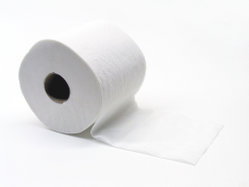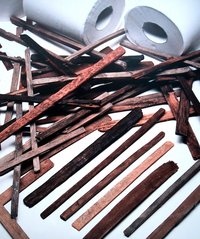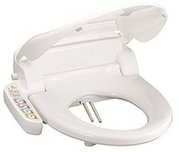Toilet paper

Toilet paper, lavatory paper or toilet tissue is a tissue paper product designed for the cleaning of the anus after defecation or the genitals after urination.
Toilet paper possesses a different composition from facial tissues. Toilet paper is designed to break apart when wet so as to not clog drain pipes, although poorer countries don't have this luxury. Toilet paper is designed to decompose in septic tanks, whereas most septic tank manufacturers advise against flushing facial tissues into a septic tank.
Toilet paper is sometimes euphemistically called "bathroom tissue", especially in commercials.
History

Records of human usage of toilet paper first appeared in China, during the 14th century.
The first factory-made paper marketed exclusively for toilet use was produced by Joseph Cayetty in the United States in 1857. Cayetty's name was printed on every sheet.
Before this invention, wealthy people used wool, lace or hemp for their ablutions, while less wealthy people used their hand, defecated into rivers, or cleaned themselves with various materials such as rags, wood shavings, leaves, grass, hay, stone, sand, moss, water, snow, maize husks, or seashells, depending upon the country and weather conditions or social customs. In Ancient Rome, a sponge was commonly used.
In some parts of the world, the use of newspaper, or telephone directory pages were common. Old Farmer's Almanac was sold with a hole punched in the corner so it could be hung on a nail in the outhouse. The widely-distributed Sears catalogue was also a popular choice until it began to be printed on glossy paper (at which point some people wrote to the company to complain). In Hervé Bazin's Viper in the Fist, a Catholic family uses pages of the Catholic newspaper La Croix after cutting off the image of the Calvary.
In monarchical Russia, subordinate stamped the toilet paper with imperial arms for the use of the Tsar. In the court of Henry VIII of England, the Groom of the Stool was given the job of cleaning the royal posterior with his hand. The Groom of the Stool was both a highly respected and coveted position. For security reasons, only a highly trusted courtier would be chosen and it was coveted because of the influence he might have with the king, daily having the opportunity to be alone with His Majesty.
The use of water to clean oneself is common in the Muslim countries, where people use their left hand to clean themselves, and their right hand for eating. In parts of Africa, the converse is true, and a right-handed handshake could be considered rude. The use of water in Muslim countries is due to the fact that Muslim sharia encourages washing the anus after defecation. Toilet paper is rarely encountered in household toilets in Muslim countries and a hose with a water sprayer or a bucket full of water and a jug is found instead. Water is widely used in Japan and India as well.
Timeline
- 14th century: toilet paper first produced in China (for the Emperor's use)
- 1596: invention of the flushing toilet by Sir John Harington
- 1700s: newspaper is a popular choice of toilet paper since it is widely available
- 1710s: bidet invented
- 1857: Joseph Cayetty sells first factory-made toilet paper in the USA
- 1879: Scott Paper Company sells the first toilet paper on a roll, although initially they do not print their company name on the packaging
- late 19th century: rolls of perforated toilet paper available for the first time, replaces razor or knife on dispensers
- 1890s: Sears catalogue first becomes available, commonly used in rural America
- 1900: plumbing improvements of the Victorian era have led to wide use of flushing toilet and (in Europe) the bidet
- 1930s: Sears starts publishing its catalogue on less absorbent glossy paper
- 1935: Northern Tissue advertises its toilet paper as "splinter-free"
- 1942: first two-ply toilet paper, St. Andrew's Paper Mill in England, toilet paper becomes softer and more pliable
- 1943: novelty toilet paper printed with images of Hitler
- 1973 December 19: comedian Johnny Carson causes a three week toilet paper shortage in the USA after a joke scares consumers into stockpiling supplies
- 1980: the paperless toilet invented in Japan (combination toilet, bidet and drying element, see Japanese toilet)
- 1990-1991: Gulf War, American troops camouflage tanks with toilet paper
- 1990s: tissues containing ingredients like aloe begin to be heavily marketed in the USA
- 1990s: in the United Kingdom, Andrex sells the first moist toilet tissues (compare wet wipes or baby wipes)
- Early 2000s: In the wake of the September 11th Attacks, novelty toilet papers in the USA started getting printed with images of Osama Bin Laden.
- 2005: Renova launched the first Black Toilet Paper.
Modern toilet paper
The advantages of toilet paper are that it is easy and intuitive to use, fairly absorbent, can be conveniently made available near toilets and it can be flushed in most countries where toilet paper is common. In areas where septic tanks are not common, and in most developing countries, used toilet paper is normally placed in a tin or dustbin next to the toilet as the plumbing or septic system cannot cope with toilet paper. Misplacing the soiled paper can lead to a serious faux pas, regardless of culture.
Toilet paper is available in several types of paper, a variety of colors, decorations, and textures, to appeal to individual preference. Toilet paper is typically made from recycled paper. Environmentally friendly toilet paper may also be unbleached, which reduces pollution of waterways and some people consider to be safer, as fewer chemicals are used.
Two-ply toilet paper is the standard in many countries, although one-ply is often available and marketed as a budget option, it may also be more appropriate for use in toilets on boats and in camper-vans. Toilet paper, especially if it is marketed as "luxury", may be quilted or rippled (embossed), perfumed, colored or patterned, medicated (with anti bacterial chemicals), treated with aloe, etc. Many novelty designs are also available on toilet paper, from cute cartoon animals via pictures of disfavored political celebrities to pictures of dollar bills. Women who are prone to vaginal Candidiasis yeast infections are advised by some medical experts to use white, unperfumed toilet paper.
Moist toilet paper was first introduced by the Kimberly-Clark Corporation in the United Kingdom by Andrex in the 1990s, and in the United States in 2001, two countries in which bidets are rare. It is designed to clean better than dry toilet paper after defecation, and may be useful for women during menstruation.
The manufacture of toilet paper is a large industry. According to U.S. company Charmin, an American uses an average of 57 sheets of toilet paper a day (20,805 a year). The toilet paper market is worth about US$2.4 billion a year in America alone.
The term toilet paper has been used throughout this article but it is often known by other (mostly slang) names such as shit tickets, TP, toilet tissue, toilet roll, striking paper, loo roll, bumf, bumfodder, bog roll, date roll, and ass wipe. "TP" is often used as a verb (we TPed the school principal's house) where it means throwing rolls of toilet paper over large objects (trees, cars, houses) to leave long streams of toilet paper fluttering in the breeze. The 1990s animated series Beavis and Butt-Head frequently referred to toilet paper as "TP" ("I need TP for my bunghole"), and the terminology subsequently caught on among the general public. Toilet paper is also often used, due to its availability and absorbent properties, by school children to form wet missiles to throw at people, windows, walls or the ceiling (where it sticks, dries and sets, to the dismay of the janitors). Some practitioners refer to these missiles as "spidey tracers," in a nod to the webs slung by the comic book character Spider-Man (who ironically formulates his webbing to dissolve in an hour, so as to not leave a mess everywhere). In the late 1960s and 1970s, British football supporters would frequently respond to moments of excitement or frustration by hurling large numbers of toilet rolls from the stands on to the pitch. The resulting streamers often required clearing away to the sidelines before the game could proceed.
Installation
There are two common methods of installing toilet paper rolls on a toilet roll holder. Often a matter of stern debate, and a contentious problem in households with opposing viewpoints, the variances are mainly that of personal preference. The first method of installation has the edge of the roll facing away from the wall and commonly facing the toilet. This method allows the defecator easy access to grab the toilet paper and pull off the desired amount of paper, as the roll spins toward the user.
The second method of installation has the edge of the roll facing the wall and commonly facing away from the toilet. This method is a bit more difficult for the defecator to grab the toilet paper, as the roll spins it spins away from the user. An advantage to this method is that a household with toddlers is less likely to have toilet paper spun off the roll. This is because a toddler is most likely to spin the roll toward them. In the case of this installation, as the roll spins toward the toddler, the paper remains wound on the roll.
A third (but far less common) toilet paper installation method is to dispense with any roller mechanism at all, or use a vertical toilet roll holder.
Another method of dispensing the paper does not use a roll at all. Cut sheets are stacked in a dispenser, folded in such a way that removing a sheet causes the next sheet to protrude from the dispenser. This method has the advantage that it can be refilled at any time without waiting for the supply to run out completely (as would be the case with a roll) and is therefore popular in public buildings. It is also commonly used on the rail transports where the motion of the train would cause a roll to rotate and cause a mess.
Modern alternatives
In France, toilet sanitation was supplemented by the invention of the bidet in the 1710s. With the improvements to plumbing in the Victorian era the bidet moved from the bedroom (where it was kept with the chamber pot) to the bathroom. Modern bidets use a stream of warm water to cleanse the genitals and anus (before modern plumbing, bidets sometimes had a hand-crank to achieve the same effect). The bidet is commonplace in many European countries, especially in France and Italy, and also in Japan where approximately half of all households have a form of bidet. It is also very popular in the Middle East.

- Main article: Japanese toilet
The first "paperless" toilet was invented in Japan in 1980. It is a combination toilet, bidet and drier, controlled by an electronic panel next to the toilet seat. This has famously led to tourists accidentally activating the bidet and causing a jet of water to shoot high into the air and spray all over the bathroom floor, usually a result of investigating the unfamiliar fixture's buttons, all of course labeled in Japanese (the fact that some toilets use a button on the same panel to flush exacerbated the problem). Many modern Japanese bidet toilets, especially in hotels and public areas, are labeled with pictograms to avoid the problem, and some newer models even have a sensor that will refuse to activate the bidet unless it detects someone actually sitting on the toilet.
In some parts of Asia especially in the Indian sub-continent a water container referred to as a Lota is used to pour water down the back passage to remove feces using the hands. Since there is no universal design for a Lota, anything from a flowering pot to a milk jug can be used as one. This practice has spread to North America and Europe with the sub-continental diaspora.
Another popular alternative resembles a miniature shower and is termed as a "health faucet". It is placed on a holder near the toilet, thus enabling the person using it to have it within an arm's length for easy accessibility.
See also
- Paper
- Bidet, Toilet, Domestic water system
- Sewage, Sewage treatment
- Hygiene
- Excretion, Urination, Defecation
- Toilet humour
- Kimberly-Clark, Procter & Gamble
- toilet roll holder
External links
- Toilet paper facts on ToiletPaperWorld.com
- New Jersey's standard for government suppliers -- incl dimensions, ream weight, and Handle-o-Meter
- The virtual toilet paper museum. - Has new and vintage specimens of toilet paper.
